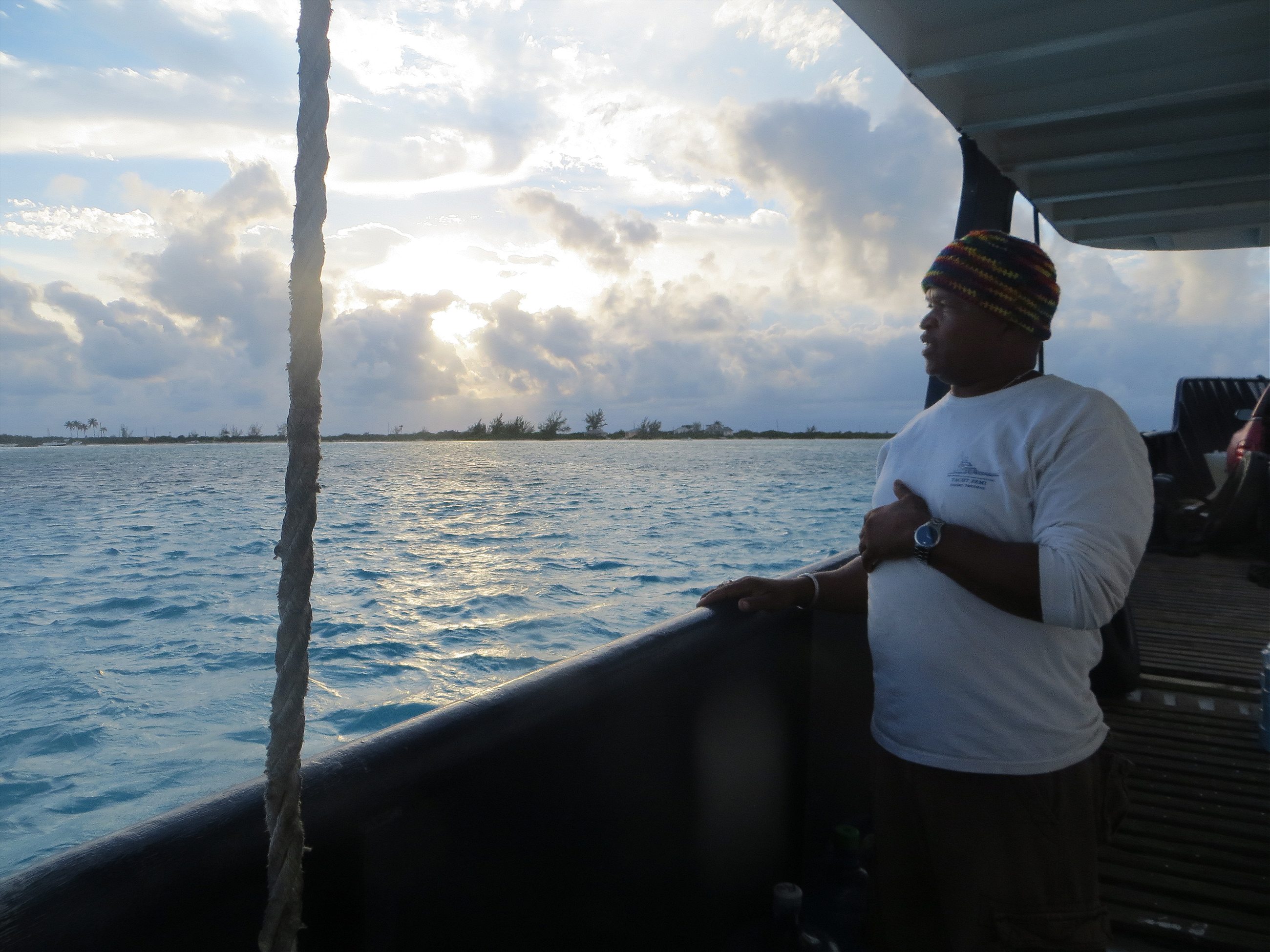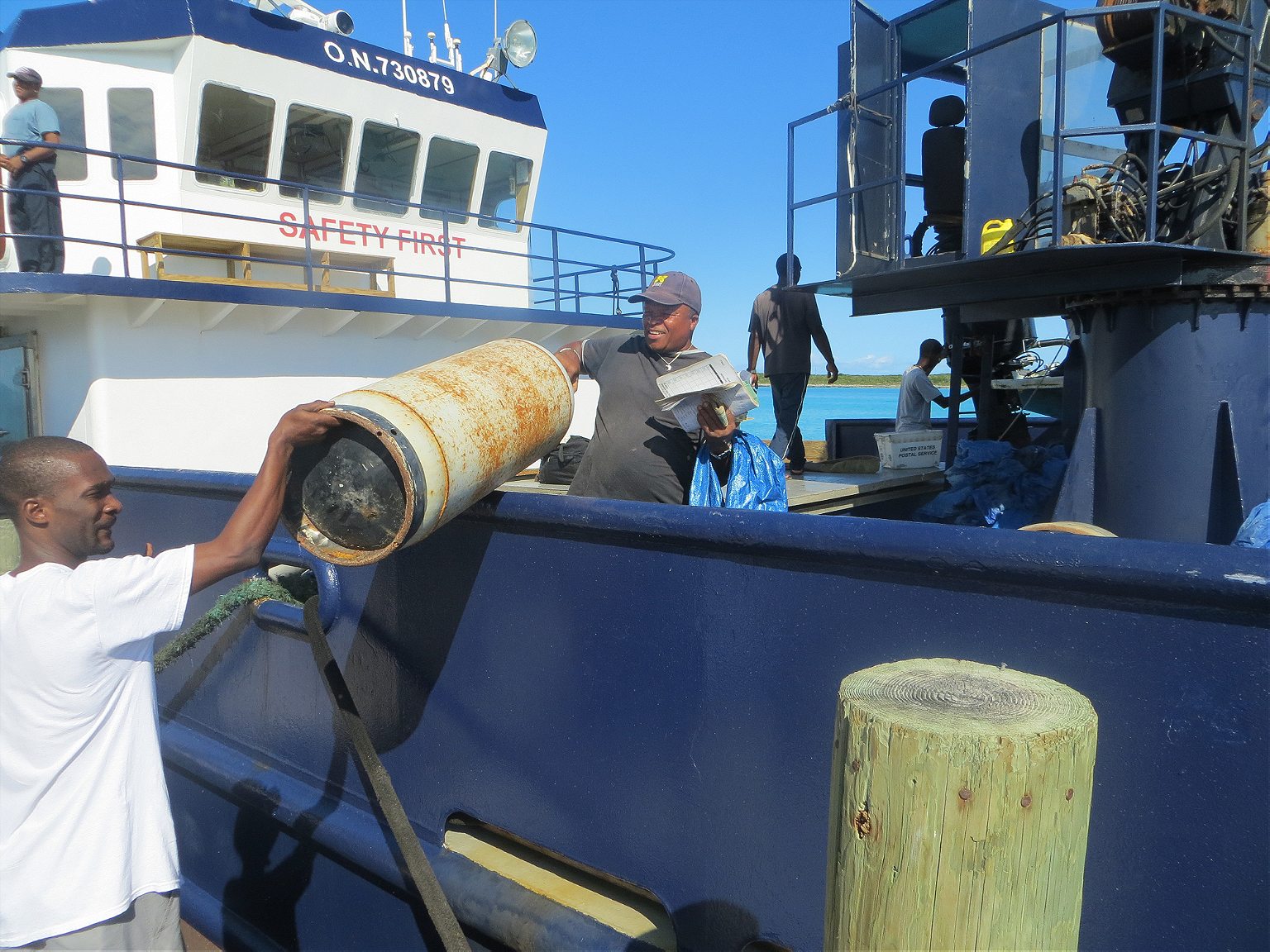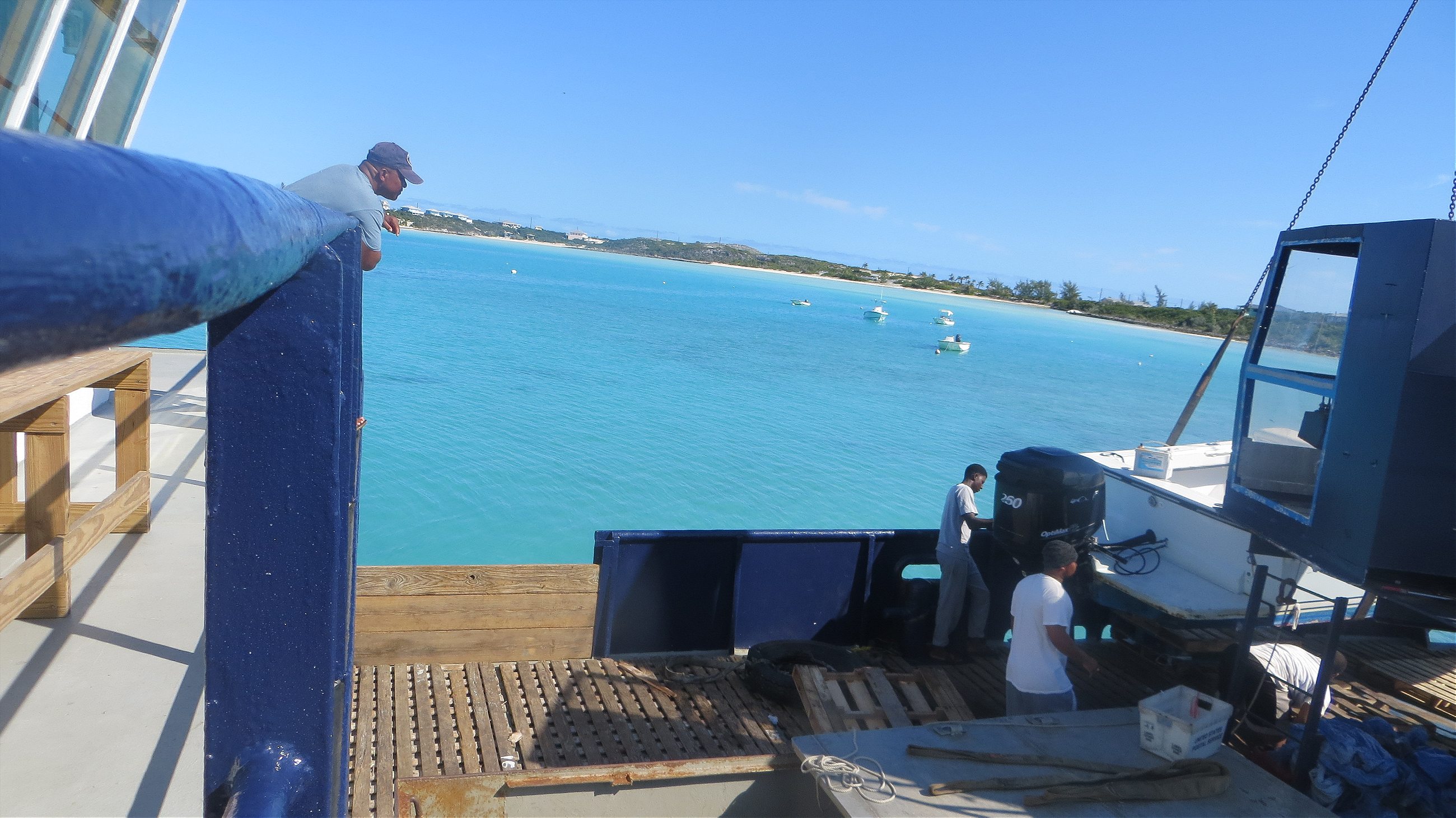Mail boats are essential to the Bahamas’ sprawling archipelago, transporting everything from propane to livestock to coffins.
As we settle onto the benches on the starboard side of his Bahamian mail boat, first mate Cephas Maycock tells me about the time his former vessel sank, nearly 16 years ago. The sky overhead has turned from dark to ominous, and the cracks of thunder make it difficult to hear the tale. As the boat pitches back and forth, I put a hand out to steady myself. Maycock mentions that the sea was rough the night that the boat sank, just like it is tonight.
“All I was saying when I roll [the lifeboats] out is, ‘Please god, let these things do what they were supposed to do!’” Maycock says. He bursts out laughing, rolling his fist into a ball in front of his mouth. It is my first night of a four-day journey on the MV Captain C, and the first mate isn’t exactly making me feel at ease.
An archipelago of 700 habitable islands, the Bahamas are scattered over 100,000 square miles of sea. Although over the last 50 years there has been a large migration to the capital city of Nassau on New Providence Island, around 30 percent of the country’s population—about 105,000 people—still lives on the so-called Family Islands. For these Bahamians the mail boat system is essential, providing an affordable mode of transportation and, perhaps most importantly, it is responsible for shipping nearly all basic items to the islands, including gasoline, boats, propane, golf carts, produce, furniture, cement, dry goods, livestock, and even coffins. “The stuff they need on the mail boats you can’t bring on a plane,” Maycock tells me.
Maycock, who owns the boat with his younger brother, Etienne Maycock, is well known in the settlements along the Captain C’s route, which begins in Potter’s Cay in Nassau; heads through the Exumas, a district of the Bahamas consisting of over 365 islands, down to its southerly-most point, the Ragged Island chain; and then does the route in reverse. While Duncan Town on Ragged Island is always the final destination, the stops along the way in the Exumas—Staniel Cay, Black Point, Little Farmer’s Cay—can change, depending on weather and necessity.

I caught the mail boat in Staniel Cay, a sleepy town in the Exumas. For $120 round trip, I would travel over 350 miles through piercing aquamarine waters, with no land in sight, save for the occasional cay.
The days leading up my journey are hectic because the mail boat, which is to ostensibly arrive on Wednesday, could appear any time. There are two false alarms and I learn the vessel was beholden to no one.
Finally on the boat, we troll slowly out of Staniel Cay’s harbor, passing the Thunderball Grotto, a cave named for the James Bond movie that filmed a scene there in the early 1960s. It is just after the Christmas and New Year’s holidays and there are nearly 30 other passengers on board, most of whom are returning to Ragged, as they call it, after spending the holidays in Nassau. We unload a few passengers and goods at Black Point and continue on our way south.
The boat is nearly overbooked and I am told to put my luggage in the captain’s cabin. Maycock promises he will figure something out. Bunk beds are stacked three high, built onto either side of the cabins. People are spilling out into the hallway, two small girls running back and forth between their rooms. I don’t see how I will fit anywhere but I trust that Maycock will indeed figure something out.
We cross over to the ocean side of the Exumas, the seas swelling. I speak with some of the other passengers. Percy Rolle, who owns J’s Bar and Grill on Little Farmer’s, uses the mail boat to resupply his bar once a month and has for the past 15 years. The plane, he says, is too expensive.
The government docks at Little Farmer’s are being redone and so instead a metal catamaran chugs out to meet us. It ferries the passengers in two loads and then returns for the cargo. Most of the freight is for the construction of the new docks. The sea is rough as the mail boat’s crane delicately maneuvers loads onto the catamaran. After ten minutes, it’s clear that the storm is not subsiding and so we leave early to stay ahead of the weather. It’s an overnight trip to Ragged.
BOAT THEFT IS RAMPANT IN THE BAHAMAS
Maycock and I walk along the stern, where a group of men from Ragged are camped out. It is the last day of the holidays and there is a festive mode in the air. They drink rum, and there’s a heavy scent of marijuana. But the men still have a job to do: Two fisherman’s boats—an Abaco Skiff and an Albury Brothers—are being towed behind us, and the men are watching the lines, constantly adjusting the scope so that the boats don’t cross or crash into each other. The boats were brought along as what the islanders call, “insurance.” Boat theft is rampant in the Bahamas, and since so many Ragged Island residents were gone over the winter holidays, the fishermen who couldn’t take their boats out of the water towed them to Nassau instead.
Growing up as a teenager in Duncan Town, Maycock and his brother worked on the sea with their father, who was nicknamed “Big Wally,” spending weekends and summer vacations on the boat. Wally began his seafaring career sailing between Cuba, Haiti, and the Ragged Islands, transporting marmalade from Cuba; sugarcane, plantains, mangos and other fruits from Haiti; and sea salt and dried fish and conch from Ragged.
Maycock recalls that there were nearly 400 people on the island when he was boy in the 1960s. But because of a combination of factors, including the cooling of trade relations between the Bahamas and Cuba, as well as the closure of the Duncan Town port, the island now has around 72 residents. It is one of the smallest inhabited islands in the Bahamas, as well as being one of the more remote islands.
Other than mail boat, the island chain is only accessible by an expensive charter flight from George Town in the Exumas, or from Nassau.
After a night of stormy seas out on the water, we wake up in the Ragged Islands. The Captain C spends the morning and a portion of the afternoon at the government docks in Duncan Town, the only settlement down here. Weather permitting, the mail boat comes once a week, which means it is welcomed with a flurry of activity.

Marvin Clarke, the boat’s engineer, begins working the crane on the dock. He unloads a red Ford pick-up truck from the hull of the boat, the crew calmly pulling on ropes to ensure it lands correctly. A few trucks load up with as many passengers as they can fit and head off towards Duncan Town, which is located a mile and half away. Like the metal catamaran, when they are finished with the people, they will then begin to transport cargo to the town, spending the day dropping off cases of beer and chickens as well as propane tanks, eggs, gasoline.
Since its inception, which some experts say was as early as 1804, the mail boat system has been subsidized in some way. Although 70 percent of Bahamians now live on New Providence, the Family Islands are seen as an integral part of Bahamian culture and history. Without subsidies, many of the routes that serve around 45 communities would cease to exist.
I spend the morning on Ragged with Nino Francis, the self-proclaimed “salt-man” who moved to the island 19 years ago with his girlfriend. Although most people on the island farm salt for personal consumption or small sales, Francis’ passion is on another level.

“That’s one thing about salt is you can store it for life,” he tells me as he reaches into a barrel and grabs a handful of sea salt, rubbing his fingers to his palm. As the salt dribbles down, he points out how pure it is.
He stores his extra salt in his old house, which sits next to his new one. The roof of his old house is gone, large chunks of stucco are missing and weathered wood outlines where the windows and doors were. A few houses that dot the settlement have this forgotten look, as if the residents just disappeared one day.
He is one of the few people who sells rock salt and after being featured on a popular local TV show, he says his business, Bahamas Salt, has been “skyrocketing.” Francis receives orders by phone or Facebook and ships the salt weekly on the mail boat, writing the recipient’s name and the salt’s destination in permanent marker on the bag.
In addition to maintaining life on the Family Islands, the mail boat system was seen as a component of building a black middle class after British rule. After gaining independence, the government actively encouraged black Bahamian captainship and ownership of the mail boat routes. It lent money to black Bahamians to modernize their fleets, encouraging a shift from wooden to steel hull boats.
Later, I sit on the Captain C with Clarke, the boat’s engineer. At 51, he is as silent as Maycock is gregarious. Clarke is not a Maycock, but has been with the brothers for over 28 years and is considered to be family. Meanwhile, the rest of the crew trickles in. There is a flurry of activity as the last of the Duncan Town residents come by to unload their frozen fish and squid into the freezer before we leave. Some are shipping it to their family who will sell it on their behalf, while others use Maycock to act as their agent in Nassau.

The next morning, I wake to the slow grumbling of the engine stopping. It’s still early and I can see the orange glimmer of sunrise outside my cabin window. We are in Little Farmer’s. The metal catamaran appears in the distance and we sit, quietly waiting as the morning unfolds. There is a breakfast of Bahamian stew and bread in the kitchen as I make my instant coffee.
We will make two more stops today. While in port, Maycock fills gasoline canisters for residents, carefully sucking a hose before putting it under the container’s lip.
We head to Nassau in the late afternoon, when the day’s drop-offs are complete. The nearly 82-mile journey takes us through the Exuma Cays Land and Sea Park, a protected chain of over 18 islands.
We troll slowly through the park for hours; its cays pop up again and again on the starboard side, along with oversized yachts in the designated moorings. As soon as it seems the park cannot go on any longer, another outcropping of islands appears on the horizon and the Captain C sails quietly by.